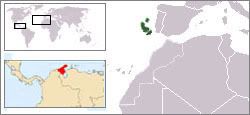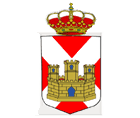San Pedro
From Ipon
| Line 53: | Line 53: | ||
===Pedrian Empire=== | ===Pedrian Empire=== | ||
| - | In 1445, Ignacio Jimenez sailed with a fleet of ships towards a the New World. They intended to sail to Hispanola, but wound up at current-day Mesias. Since the land had not been claimed by the Spanish Empire yet, they claimed the area for San Pedro. The first | + | In 1445, Ignacio Jimenez sailed with a fleet of ships towards a the New World. They intended to sail to Hispanola, but wound up at current-day Mesias. Since the land had not been claimed by the Spanish Empire yet, they claimed the area for San Pedro. The first Pedronese conquistadors were brutal and destroyed several ancient villages. Villagers were sold into slavery and women were raped, and those who didn't follow orders were killed. When these acts were revealed to the royal family and church hierarchy the conquistadors were expelled from San Pedro territory, although the only reason they were expelled was for their degeneracy. Later on a large influx of Jesuits were granted asylum in Mesias because they were expelled from Spanish territory. This would temporarily make the small colonial backwater of Santa Leon a capital for the "Company of Jesus" and thus skyrocketed local trade. |
| - | + | With the recent influence of the Dominican friar Bartolome de las Casas, Pedronese colonists were required to follow certain criteria in order to preserve the local native population, which many today consider a huge milestone towards indigenous rights. Because of the friar's help in Mesias an entire city was named after him, San Bartolome de las Casas.(An additionaly flattering "saint" title was added to the city's name as well.) | |
| - | + | ==Demographics== | |
| + | The majority of people in San Pedro are Pedronese. The Pedronese people are very similar to Catalonians, however Pedronese people speak Spanish. | ||
| + | The next largest ethnic group are Latin Americans, followed by North African Arabs, Indians and a small gypsy minority. | ||
| + | |||
| + | ===Religion=== | ||
| + | |||
| + | The constitution of San Pedro provides freedom of religion for all citizens, however Roman Catholicism is generally considered the "official" religion with royal affairs. The nation is home to at least 20 monasteries, most of which are Franciscan. Islam is the nation's second largest religion with about 8% of people adhering to the faith, almost entirely consisting of Sunnis. There are also very small Hindu and Jewish communities in Carife. | ||
==Major Companies== | ==Major Companies== | ||
| Line 64: | Line 70: | ||
El Corte Arboles | El Corte Arboles | ||
[[Telesegundo]] | [[Telesegundo]] | ||
| - | |||
| - | |||
| - | |||
| - | |||
| - | |||
| - | |||
| - | |||
| - | |||
| - | |||
| - | |||
| - | |||
| - | |||
| - | |||
| - | |||
| - | |||
| - | |||
| - | |||
| - | |||
| - | |||
| - | |||
| - | |||
| - | |||
Revision as of 13:08, 29 December 2008
| |||||||
| Motto: '"La paz para el Imperio"' | |||||||

| |||||||
| San Pedro @ Simtropolis | |||||||
| Capital | Carife | ||||||
| Largest city | Santa Leon (unofficial) | ||||||
| Official language(s) | Spanish, Portuguese | ||||||
| Government Monarch
Prime Minister | Constitutional Monarchy Carlos IV Raúl Olivares | ||||||
| Constitutional Monarchy Roman Colonization Moorish Invasion Independence from Kingdom of Seville Governmental Reforms | 123 BC 600 AD 1332 AD 1975 AD | ||||||
| Area • Total • Water (%) | 30,000 km² 70 | ||||||
| Population • 2007 est. • 2006 census • Density | 10,600,200 total () 700/km² () | ||||||
| GDP (PPP) • Total • Per capita | $1.310 trillion $33,700 | ||||||
| HDI | 0.820 | ||||||
| Currency | Corona (Cr)
| ||||||
| Time zone • Summer (DST) | West Europe, East Coast standard (UTC) (UTC{{{utc_offset_DST}}}) | ||||||
| Internet TLD | .sp | ||||||
| Calling code | +351
| ||||||
The Kingdom of San Pedro is a small nation off the coast of Portugal in the Atlantic sea.
Contents |
History
Early History
The first sign of civilization is the colonization of San Pedro (then called Pedriona) by the Roman Empire in 123 BC. After the collapse of the Roman Empire, it was conquered by Moors from Al Andalus.
After the reconquest of Spain, armies from Seville removed the Moors from San Pedro and claimed the island for Spain. After a couple of years a revolutionary group fought against the Spanish rulers and the island went to war with Spain. Portugal intervened, believing the war to be against them, and the island won. The royal family of San Pedro was then instituted and has been around ever since.
Pedrian Empire
In 1445, Ignacio Jimenez sailed with a fleet of ships towards a the New World. They intended to sail to Hispanola, but wound up at current-day Mesias. Since the land had not been claimed by the Spanish Empire yet, they claimed the area for San Pedro. The first Pedronese conquistadors were brutal and destroyed several ancient villages. Villagers were sold into slavery and women were raped, and those who didn't follow orders were killed. When these acts were revealed to the royal family and church hierarchy the conquistadors were expelled from San Pedro territory, although the only reason they were expelled was for their degeneracy. Later on a large influx of Jesuits were granted asylum in Mesias because they were expelled from Spanish territory. This would temporarily make the small colonial backwater of Santa Leon a capital for the "Company of Jesus" and thus skyrocketed local trade.
With the recent influence of the Dominican friar Bartolome de las Casas, Pedronese colonists were required to follow certain criteria in order to preserve the local native population, which many today consider a huge milestone towards indigenous rights. Because of the friar's help in Mesias an entire city was named after him, San Bartolome de las Casas.(An additionaly flattering "saint" title was added to the city's name as well.)
Demographics
The majority of people in San Pedro are Pedronese. The Pedronese people are very similar to Catalonians, however Pedronese people speak Spanish. The next largest ethnic group are Latin Americans, followed by North African Arabs, Indians and a small gypsy minority.
Religion
The constitution of San Pedro provides freedom of religion for all citizens, however Roman Catholicism is generally considered the "official" religion with royal affairs. The nation is home to at least 20 monasteries, most of which are Franciscan. Islam is the nation's second largest religion with about 8% of people adhering to the faith, almost entirely consisting of Sunnis. There are also very small Hindu and Jewish communities in Carife.
Major Companies
AeroPedro El Corte Arboles Telesegundo


